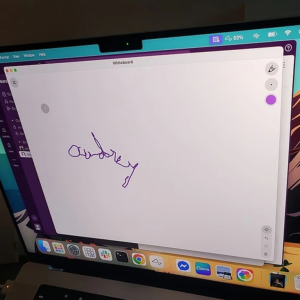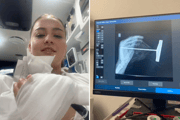You Won’t Believe What Happened After a Paralysed Woman Got Elon Musk’s Neuralink Implant
By
Gian T
- Replies 0
Technology has a way of surprising us, but every now and then, a story comes along that truly feels like something out of science fiction. This week, we’re bringing you one of those stories—a tale of hope, resilience, and the remarkable power of the human mind (with a little help from Elon Musk’s latest invention).
Meet Audrey Crews, a woman who, after a devastating car accident in 2005, was left a quadriplegic at just 16 years old. For two decades, Audrey’s world was changed in ways most of us can only imagine. But now, thanks to a tiny chip and a team of brilliant minds, she’s made history—and inspired millions.
Earlier this month, Audrey became the first woman in the world to receive a Neuralink brain implant, a device developed by Elon Musk’s company with the ambitious goal of bridging the gap between the human brain and computers. The procedure took place at the University of Miami Health Centre, where surgeons delicately inserted over 100 microscopic threads—each thinner than a human hair—into her motor cortex, the part of the brain responsible for movement.
The implant itself is about the size of a 10-cent coin and sits comfortably inside the skull. It’s powered by a small battery that charges wirelessly (no need for any unsightly cables or plugs sticking out of your head!). The magic happens when the chip picks up electrical signals from Audrey’s brain and sends them, via Bluetooth, to a computer or smartphone running Neuralink’s software.
Writing Her Name—With Her Mind!
So, what does all this high-tech wizardry actually mean for Audrey? In a word: independence. For the first time in 20 years, Audrey was able to write her own name—simply by thinking about it. She shared her achievement on X (formerly Twitter), showing the world how she could select a coloured cursor, sign her name, draw pictures, scroll with a mouse, and even use a keyboard—all without moving a muscle.
'I tried writing my name for the first time in 20 years. I’m working on it. Lol,' she posted, adding, 'I am the first woman in the world to do this.'
Audrey’s new abilities don’t stop at writing. She’s been taking requests from social media followers, drawing everything from cats to suns and trees, and even playing simulation games that test her speed and accuracy. Imagine being able to control your computer just by thinking—no hands required!
A Message From Elon Musk Himself
The story caught the attention of Elon Musk, who responded to Audrey’s post with awe: 'She is controlling her computer just by thinking. Most people don’t realise this is possible.' And he’s right—this is the kind of breakthrough that could change lives for millions of people living with paralysis or neurological conditions.
What’s Next for Audrey—and for Neuralink?
While the Neuralink chip won’t restore movement to Audrey’s limbs, it’s already given her a new way to communicate and express herself. She’s even planning to write a book about her experiences, hoping to inspire others and shed light on the possibilities of this technology.
The device is still in its early days—Audrey is only the ninth person in the world to receive it—but the potential is enormous. Imagine a future where people with spinal injuries, ALS, or other conditions can interact with the world in ways that were once thought impossible.
A Glimpse Into Tomorrow
For many of us, the idea of controlling a computer with our thoughts sounds like something from Star Trek. But as Audrey herself put it: 'Not in all my wildest dreams, but the future is here.'
It’s a powerful reminder that, no matter our age or circumstances, the world is full of surprises—and sometimes, the next big leap is just around the corner.
What Do You Think?
We’d love to hear your thoughts, members! Do you find this technology exciting, or does it make you a bit nervous? Would you consider a brain implant if it could help you regain lost abilities or independence? And what do you hope the future holds for medical technology?
 Share your thoughts, stories, and questions in the comments below—let’s get the conversation started!
Share your thoughts, stories, and questions in the comments below—let’s get the conversation started!
Read more: Medical breakthrough offers new hope for regaining movement
Meet Audrey Crews, a woman who, after a devastating car accident in 2005, was left a quadriplegic at just 16 years old. For two decades, Audrey’s world was changed in ways most of us can only imagine. But now, thanks to a tiny chip and a team of brilliant minds, she’s made history—and inspired millions.
Earlier this month, Audrey became the first woman in the world to receive a Neuralink brain implant, a device developed by Elon Musk’s company with the ambitious goal of bridging the gap between the human brain and computers. The procedure took place at the University of Miami Health Centre, where surgeons delicately inserted over 100 microscopic threads—each thinner than a human hair—into her motor cortex, the part of the brain responsible for movement.
The implant itself is about the size of a 10-cent coin and sits comfortably inside the skull. It’s powered by a small battery that charges wirelessly (no need for any unsightly cables or plugs sticking out of your head!). The magic happens when the chip picks up electrical signals from Audrey’s brain and sends them, via Bluetooth, to a computer or smartphone running Neuralink’s software.
Writing Her Name—With Her Mind!
So, what does all this high-tech wizardry actually mean for Audrey? In a word: independence. For the first time in 20 years, Audrey was able to write her own name—simply by thinking about it. She shared her achievement on X (formerly Twitter), showing the world how she could select a coloured cursor, sign her name, draw pictures, scroll with a mouse, and even use a keyboard—all without moving a muscle.
'I tried writing my name for the first time in 20 years. I’m working on it. Lol,' she posted, adding, 'I am the first woman in the world to do this.'
Audrey’s new abilities don’t stop at writing. She’s been taking requests from social media followers, drawing everything from cats to suns and trees, and even playing simulation games that test her speed and accuracy. Imagine being able to control your computer just by thinking—no hands required!
A Message From Elon Musk Himself
The story caught the attention of Elon Musk, who responded to Audrey’s post with awe: 'She is controlling her computer just by thinking. Most people don’t realise this is possible.' And he’s right—this is the kind of breakthrough that could change lives for millions of people living with paralysis or neurological conditions.
What’s Next for Audrey—and for Neuralink?
While the Neuralink chip won’t restore movement to Audrey’s limbs, it’s already given her a new way to communicate and express herself. She’s even planning to write a book about her experiences, hoping to inspire others and shed light on the possibilities of this technology.
The device is still in its early days—Audrey is only the ninth person in the world to receive it—but the potential is enormous. Imagine a future where people with spinal injuries, ALS, or other conditions can interact with the world in ways that were once thought impossible.
A Glimpse Into Tomorrow
For many of us, the idea of controlling a computer with our thoughts sounds like something from Star Trek. But as Audrey herself put it: 'Not in all my wildest dreams, but the future is here.'
It’s a powerful reminder that, no matter our age or circumstances, the world is full of surprises—and sometimes, the next big leap is just around the corner.
What Do You Think?
We’d love to hear your thoughts, members! Do you find this technology exciting, or does it make you a bit nervous? Would you consider a brain implant if it could help you regain lost abilities or independence? And what do you hope the future holds for medical technology?
Key Takeaways
- A paralysed woman, Audrey Crews, has become the first female in the world to use Elon Musk’s Neuralink brain implant, allowing her to control a computer using only her thoughts.
- After 20 years of quadriplegia, Ms Crews has been able to write her name, draw pictures, and use a keyboard and mouse telepathically, sharing her progress publicly on social media.
- The Neuralink chip, which is implanted in the brain and communicates with devices via Bluetooth, enables individuals with paralysis or neurological conditions to interact with technology in new ways.
- While the implant doesn’t restore movement to her limbs, Ms Crews is optimistic about the technology’s future and plans to write a book about her experiences with Neuralink.
Read more: Medical breakthrough offers new hope for regaining movement








